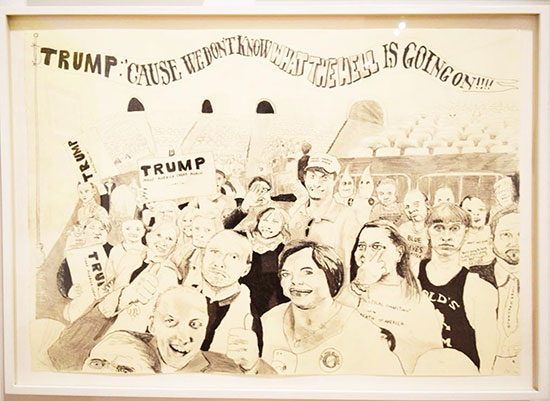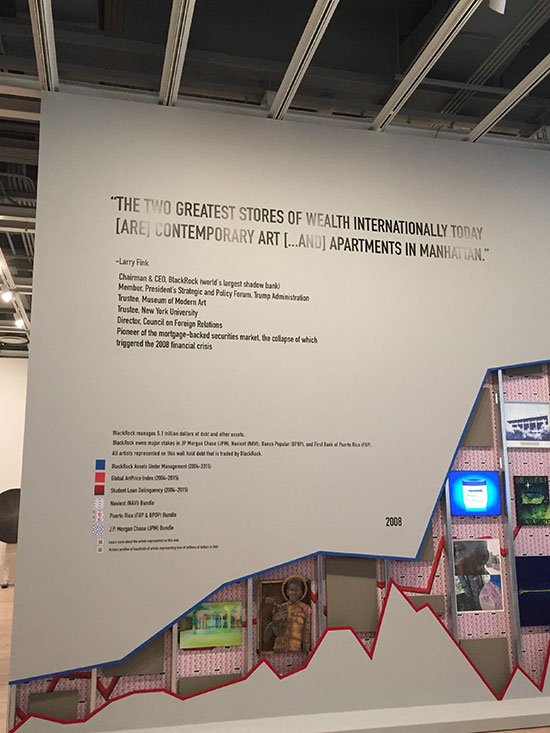The 78th Whitney Biennial survey of the art scene opens this week at the museum’s spacious new location in downtown Manhattan.
The show is curated by Christopher Y. Lew and Mia Locks, who worked with several others to create a show that provides a far-flung profile of the “formation of self and the individual’s place in a turbulent society.” The other consultants include Negar Azimi, writer and senior editor at Bidoun, a publishing and curatorial program with a focus on the Middle East; Gean Moreno, curator of programs at the Institute of Contemporary Art Miami; Aily Nash, co-curator of Projections, the New York Film Festival's artists section; and Wendy Yao, a publisher and founder of the exhibition space 356 S. Mission Rd. in Los Angeles.
Nash, together with the curators, was the co-organizer of the Biennial film program, which will screen in the Whitney's third-floor Susan and John Hess Family Theater. There wasn’t enough time at the press briefing to experience these films.
The exhibited works are spread across two floors with some pieces on the patio or in the film theater. They are largely conceptual—ideas favored over visual appearance—which is so dominant in American arts now that the word “conceptual” isn’t in much use anymore. Many observers assume that contemporary art in general is conceptual: low on pleasure, high on idea, or at least rant. This is a striking departure from the larger Armory Show in New York a couple of weeks ago where the opposite was true: high on visual pleasure, less so on idea.
The competition to get into the Whitney Biennial is fierce and dates from a pre-internet time when inclusion was a solid rung or two up the career ladder. Not true so much anymore but the perception is still there and thus racial and gender politics come into play, ensuring that the 63 included artists are spread among lots of social groups.
President Trump famously said he would halt types of immigration until we can figure out “What the hell is going on!” Not only do those same words appear on one of the exhibited art works, “What the hell is going on” seems to be the theme for the show.
.

“Trump Rally (And some of them I assume are good people)” by Celeste Dupuy-Spencer, 2016.
.
Celeste Dupuy-Spencer’s Trump Rally (And some of them I assume are good people) (above) would be shocking to someone who actually attended one of Donald Trump’s massive six-a-day rallies: the Ku Klux Klan is portrayed back near the press box and Charleston church murderer Dylan Roof leers from the foreground. This is not what happened at a Trump rally; rather this is the political Left’s fantasy of what must have happened. The only part the artist appears to have left out is the Politburo manning the election booths.
President Trump’s exasperation echoed, oddly, on both sides of the political aisle and throughout the humanities, where there is a sense of the impending collapse of our institutions. The Whitney Biennial and curators Lew and Locks, for better or worse, flesh out this worry.
Political works are always part of the artscape but rarely have a desired effect, with a few notable exceptions. Hans Haacke’s famous works detailing the interplay between museums and corporations culminated in his attempt to exhibit photos of slums owned by Harry Shapolsky et al at the Guggenheim museum. His show was canceled and the curator put on the street, resulting in a boycott of the museum by other artists.
Another crowd has appeared to carry on the work of the now 80-year-old Haacke. Occupy Museums is a self-described spin-off of Occupy Wall Street, aka the flea party, and offers a take on the predatory financial structure of BlackRock, a large investment corporation.
Occupy Museums brings it home by listing the Biennial artists who owe money to this gargantuan organization. Further, Larry Fink, the busy CEO, is a trustee for MoMA and a member of a President Trump policy forum. Not sure if all this is good or bad; it certainly does not have the more modest but clear punch of Haacke’s work.
.

Occupy Museums at the Whitney Biennial 2017.
.
Two interesting sculptures were created by one of the older and more established artists in the show, multi-media wizard Jon Kessler. Kessler is fond of humorous constructions, “performative sculptures” that have a lineage in the work of Ed Kienholtz and spin and sway and are generally bonkers in a good way. His “Exodus” was being filmed by everyone in sight at the press briefing, a knowing crowd, as seen below.
.

"Exodus" by Jon Kessler, 2016.
.
I was less keen on his larger work entitled Evolution because of its use of mannequins for figures: this is entry level figurative sculpture and its amateurishness detracts from the overall image. There are lots of quick ways to make a figure today: digital lathe, cut foam and similar methods. I hope Kessler rebuilds this piece using a better material.
There is one striking outlier in the show and that is the inclusion of 78-year-old Larry Bell, an artist of the space and light minimalism that dominated the art scene in 1960s Southern California. His giant installations of smoked glass and mirrored glass were stunning additions to the art scene and included in the seminal Primary Structures show at the Jewish Museum. His career was etched into art history books everywhere. For reasons unknown he abruptly switched to a figurative sculpture that was so strikingly poor one assumed the artist was another “Larry Bell.”
Unfortunately it was not and Bell disappeared for four decades from any serious art consideration or venue. For reasons as mysterious as the first metamorphosis, the chrysalis molted in reverse and the earlier Larry Bell is back with his unparalleled Pacific Red minimalist glass installation.
.

"Pacific Red" by Larry Bell, 2016. Colored glass.
.
_______________________________
BASIC FACTS: The Whitney Biennial is on view March 17 through June 11, 2017 at the Whitney Museum of American Art, 99 Gansevoort Street, New York, NY 10014. whitney.org/Exhibitions/2017Biennial.
_______________________________
Copyright 2017 Hamptons Art Hub LLC. All rights reserved.
